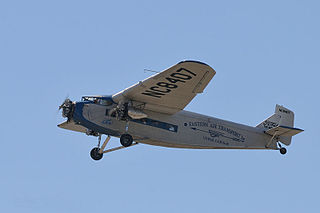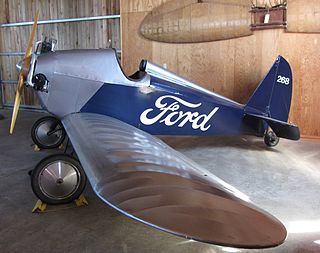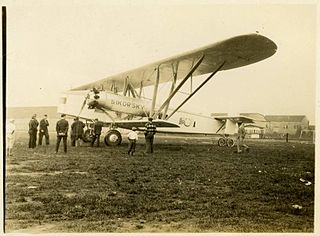Related Research Articles

A flying car or roadable aircraft is a type of vehicle which can function both as a road vehicle and as an aircraft. As used here, this includes vehicles which drive as motorcycles when on the road. The term "flying car" is also sometimes used to include hovercars and/or VTOL personal air vehicles. Many prototypes have been built since the early 20th century, using a variety of flight technologies. Most have been designed to take off and land conventionally using a runway. Although VTOL projects are increasing, none has yet been built in more than a handful of numbers.

An autogyro, also known as a gyroplane, is a type of rotorcraft that uses an unpowered rotor in free autorotation to develop lift. Forward thrust is provided independently, by an engine-driven propeller. While similar to a helicopter rotor in appearance, the autogyro's rotor must have air flowing across the rotor disc to generate rotation, and the air flows upwards through the rotor disc rather than down.

The ERCO Ercoupe is an American low-wing monoplane aircraft that was first flown in 1937. It was originally manufactured by the Engineering and Research Corporation (ERCO) shortly before World War II; several other manufacturers continued its production after the war. The final model, the Mooney M-10, first flew in 1968 and the last model year was 1970. It was designed to be the safest fixed-wing aircraft that aerospace engineering could provide at the time, and the type continues to enjoy a faithful following.

The Ford Trimotor is an American three-engined transport aircraft. Production started in 1925 by the companies of Henry Ford and ended on June 7, 1933, after 199 had been made. It was designed for the civil aviation market, but also saw service with military units.

The Ford Reliability Tour, properly called "The National Air Tour for the Edsel B. Ford Reliability Trophy", was a series of aerial tours sponsored in part by Ford from 1925 to 1931 and re-created in 2003. Top prize was the Edsel Ford Reliability Trophy. Henry and Edsel Ford were shareholders in the Stout Engineering Company. In August 1925, they purchased the entire company, making it the Stout Metal Airplane Division of the Ford Motor Company. Their product, the Stout 2-AT Pullman, was a featured plane. The plane was also used by their new airline the Ford Air Transport Service, which started regular flights in April. The flights out of Ford Airport (Dearborn) cross-marketed, and showcased Ford's new interest in aviation.

William Bushnell Stout was a pioneering American inventor, engineer, developer and designer whose works in the automotive and aviation fields were groundbreaking. Known by the nickname "Bill", Stout designed an aircraft that eventually became the Ford Trimotor and was an executive at the Ford Motor Company.

The Budd BB-1 Pioneer was an experimental United States flying boat of the 1930s utilizing the Savoia-Marchetti S.56 design. Its framework was constructed entirely of stainless steel, using a newly patented method of welding that alloy.

The Pitcairn PCA-2 was an autogyro developed in the United States in the early 1930s. It was Harold F. Pitcairn's first autogyro design to sell in quantity. It had a conventional design for its day – an airplane-like fuselage with two open cockpits in tandem, and an engine mounted tractor-fashion in the nose. The lift by the four-blade main rotor was augmented by stubby, low-set monoplane wings that also carried the control surfaces. The wingtips featured considerable dihedral that acted as winglets for added stability.

The Stout Skycar was a series of four one-off American light aircraft of the 1930s.

The Stearman-Hammond Y-1 was a 1930s American utility monoplane built by the Stearman-Hammond Aircraft Corporation and evaluated by the United States Navy and the British Royal Air Force.

The Ford Flivver is a single-seat aircraft introduced by Henry Ford as the "Model T of the Air". After a fatal crash of a prototype into the ocean off Melbourne, Florida, production plans were halted.

Stout Metal Airplane Division of the Ford Motor Company was an American aircraft manufacturer founded by William Bushnell Stout as the Stout Metal Airplane Co. in 1922. The company was purchased by Ford Motor Company in 1924 and later produced the Ford Trimotor. At the height of the Great Depression, Ford closed the aircraft design and production division in 1936, temporarily re-entering the aviation market with the production of the B-24, at the Willow Run aircraft factory during World War II.

The Stout 2-AT Pullman, or "Air Pullman", was a single engine all-metal monoplane that was used for early airline travel and air mail transport in America.

The AVE Mizar was a roadable aircraft built between 1971 and 1973 by Advanced Vehicle Engineers (AVE) of Van Nuys, Los Angeles, California. The company was started by Henry Smolinski and Harold Blake, both graduates of Northrop Institute of Technology's aeronautical engineering school.

Harry Joseph Brooks was an American test pilot. His crash of the Ford Flivver for the Stout Metal Airplane Division of the Ford Motor Company in 1928 was cited with the Great Depression as a factor in Henry Ford's exit from the aviation business.

The Sikorsky S-37 was an American twin-engine aircraft built by the Sikorsky Manufacturing Corporation. Both examples of the series were completed in 1927. The S-37 was specifically designed to compete for the Orteig Prize and would be the last land based fixed-wing aircraft Sikorsky would produce.

The Hamilton H-18 was a 1920s US four/five passenger aircraft. An early all-metal design, it reflected Junkers and Stout design practices. Though it won safety and efficiency awards only one was built.

The 1933 experimental Pitcairn PA-22 was one of the first wingless autogyros. It was controlled by movement of the rotor plane rather than the usual control surfaces, though initially the much modified lone example retained rudders as a precaution.

The Campbell Model F, a pusher configuration, two seat sport aircraft built in the 1930s, was unconventional in its day with its empennage on twin, slim booms, a cockpit under stepless, rounded, multi-panel glazing and a tricycle undercarriage.
The Ford 14-A was a prototype three-engined, large, streamlined, 32 passenger aircraft built in 1932. Though apparently completed, it never flew.
References
- ↑ "Ford, Ford-Stout". Aerofiles.com. Retrieved 8 May 2016.
- ↑ "Ford Licenses Experimental 'Flivver' Plane, Re-enters Competition With V-8 Engine". New York Times. Jan 13, 1936.
- 1 2 3 4 5 Pearce, William. "Ford 15P Personal Aircraft". oldmachinepress.com. Retrieved 8 May 2016.
- ↑ "New 'Flivver' Plane Made By Ford, Carries 2 Passengers And Baggage". The Hartford Courant. Jan 13, 1936.